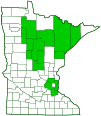Black Trumpet
(Craterellus fallax)
Conservation • Description • Habitat • Ecology • Distribution • Taxonomy
Conservation Status |
|
|||||||
| IUCN Red List | not listed |
|||||||
| NatureServe | not listed |
|||||||
| Minnesota | not listed |
|||||||
Description |
||
Black Trumpet is a common and widespread, edible mushroom. It occurs across North America but is especially common in the east. It fruits on the ground, scattered or in groups, in deciduous and mixed woodlands. It obtains its nutrients from the rootlets of oak, beech, and possibly other hardwood trees (mycorrhizal). It is often missed because its shape and color allows it to blend in with its surroundings. It sometimes stands out in sharp relief against a carpet of moss. The fruiting body is more or less trumpet-shaped. There is no sharp distinction between the stalk and the cap. The stalk is tough, hollow except at the very base, tapered, ⅜″ to 2″ long, and 3 ⁄16″ to ⅜″ wide. It is the same color or slightly paler than the underside of the cap. The cap is shaped like a funnel, 1¼″ to 3½″ high, and ¾″ to 3″ or more wide. It is tapered, hollow in the center, and broadly spread outwards at the top. The margins curved downwards, becoming wavy at maturity and splitting with age. The upper side is finely scaly, pale brown to grayish-brown when dry, dark brown to black when moist. The underside is smooth or slightly wrinkled, and colored similar tho the cap but paler. There are no gills. At maturity it is covered with a whitish spore dust with yellowish or orangish tints. The flesh is thin, tough, brittle, and grayish-brown or colored like the cap. It has a fruity fragrance reminiscent of apricots. The spore print is whitish to pinkish-orange or yellowish. |
||
Similar Species |
||
Ashen Chanterelle (Cantharellus cinereus) underside is bluish-black or bluish gray and conspicuously wrinkled with shallow, primitive gills. Blue Chanterelle (Polyozellus multiplex) cap is tinted purple or dark blue. Horn of Plenty (Craterellus cornucopioides) has a white spore print but is otherwise indistinguishable. It is common in Europe but much rarer in North America. |
||
Habitat and Hosts |
||
On the ground in deciduous or mixed woodlands. Oak, beech, and possibly other hardwoods. |
||
Ecology |
||
Season |
||
July to October |
||
Distribution |
||||
|
Sources |
|||
| 7/21/2022 | ||||
Occurrence |
||||
Common and widespread |
||||
Taxonomy |
|||
| Kingdom | Fungi (Fungi) | ||
| Subkingdom | Dikarya | ||
| Phylum | Basidiomycota (Basidiomycete Fungi) | ||
| Subphylum | Agaricomycotina (Higher Basidiomycetes) | ||
| Class | Agaricomycetes (Mushrooms, Bracket Fungi, Puffballs, and Allies) | ||
Order |
Cantharellales | ||
Family |
Hydnaceae | ||
Genus |
Craterellus (trumpets) | ||
| Subgenus | Craterellus | ||
Synonyms |
|||
|
|||
Common Names |
|||
Black Trumpet |
|||
Glossary
Mycorrhizal
A symbiotic, usually beneficial relationship between a fungus and the tiny rootlets of a plant, usually a tree.
Visitor Photos |
|||||
Share your photo of this fungus. |
|||||
| This button not working for you? Simply email us at info@MinnesotaSeasons.com. Attach one or more photos and, if you like, a caption. |
|||||
Jane Harper |
|||||
I find these every year in the same location |
|||||
 |
 |
||||
 |
|||||
Luciearl |
|||||
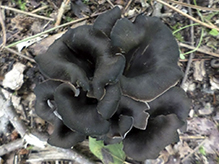 |
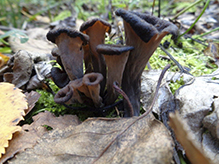 |
||||
MinnesotaSeasons.com Photos |
|||||
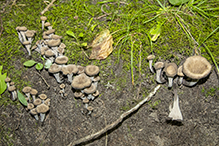 |
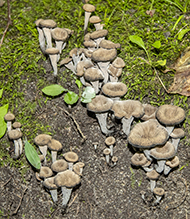 |
||||
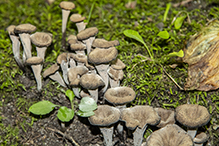 |
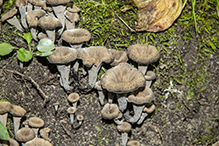 |
||||
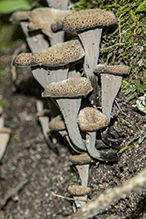 |
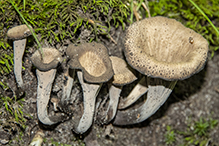 |
||||
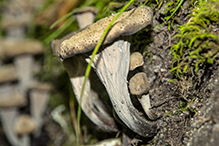 |
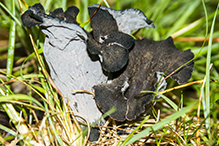 |
||||
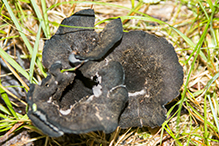 |
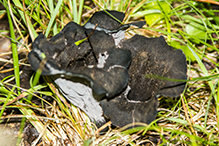 |
||||

Slideshows |
||
| Craterellus fallax - fungi kingdom Fungi Kingdom |
||
About
Published on Jan 23, 2015 Craterellus fallax - fungi kingdom |
||

Visitor Videos |
|||
Share your video of this fungus. |
|||
| This button not working for you? Simply email us at info@MinnesotaSeasons.com. Attach a video, a YouTube link, or a cloud storage link. |
|||
Other Videos |
|||
| Finding Wild Black Trumpet Mushrooms - Craterellus Fallax Wild Meat Let's Eat |
|||
About
ul 14, 2019 Finding Wild Black Trumpets is not easy... but well worth the search. Craterellus Fallax is a choice edible... However it takes a lot to make a meal. When finding black trumpets I recommend looking around moss at the bass of hardwood trees like a white oak and when you finally find the trumpets... pay close attention to the habitat and take note of your location because black trumpets will come back year after year. I really enjoy looking for them in the leaf litter... it's almost like a personal challenge because they are so hard to find at times. The Latin name for Black Trumpets is Craterellus Fallax and it has different nicknames like horn of plenty, trumpet of the dead and the black chanterelle. Black trumpets are a wonderful wild mushroom and shouldn't be overlooked. If you like spending time in the woods gathering wild edibles/mushrooms and connecting with nature or even if this is new to you... Please join the outdoor adventure. Thank you for spending your valuable time with me and Thank you for watching Wild Meat Let's Eat. |
|||
| First Black Trumpets (Craterellus fallax) of 2018 Don King |
|||
About
Jun 17, 2018 Check out my summer mushroom camp and group mushroom hikes! |
|||
| Black Trumpet Mushroom ID, Hunting Tips, & Look-Alikes Learn Your Land |
|||
About
Jul 20, 2017 The Black Trumpet (Craterellus fallax) is a choice edible mushroom found throughout the summer months in Eastern North America. Learn almost everything you'd ever want to know in this video! |
|||
| Black Trumpets and Honey Mushrooms in Wisconsin's Northwoods Wisconsin Mycological Society |
|||
About
Jun 14, 2021 Rose from Wisconsin Mycological Society along with Patrick from Blue Ridge Mycological Society of Virginia, explore Wisconsin's Northwoods and find some interesting gourmet wild edible fungus. Black Trumpets ( Craterellus fallax ) and Honey Mushrooms ( Armillaria mellea ) |
|||
| How to find black trumpet mushrooms, Craterellus fallax + flame chanterelles, Craterellus ignicolor Anna McHugh |
|||
About
Oct 18, 2021 In this video, I describe how to find and identify black trumpet mushrooms that grow in the eastern United States, Craterellus fallax. Craterellus fallax is a tasty mushroom with a fruity, earthy flavor and nice texture. Black trumpets grow in association with hardwoods throughout the summer and fall, often in the same oak and beech groves that are my favorite places to go mushroom hunting. The trouble with trumpets - if you can consider anything related to these delightful mushrooms as troublesome - is how stinking hard they are to see. Black trumpets are the incognito tab of the mushroom world. They look like curled leaves. Or tiny holes. Or shadows of mouse turds. Fortunately, they come back in the same spot year after year, and individual patches are tightly clustered enough that seeing one means it's worthwhile to hit the deck and look around the immediate vicinity. I also share how to identify a related edible mushroom, Craterellus ignicolor. Commonly called the flame chanterelle, Craterellus ignicolor is a hollow little mushroom with a nifty hole in the top (the crater in "Craterellus"). Brightly colored and sporting false gills like larger varieties of chanterelles, Craterellus ignicolor is a surely worth mentioning in any discussion of eye-catching fungi. Learn more about why I'm a fan of Craterellus fallax and Craterellus ignicolor, despite the challenges of finding them in the first place. https://youtu.be/jM_8zlIeCLM |
|||


Last Updated:
